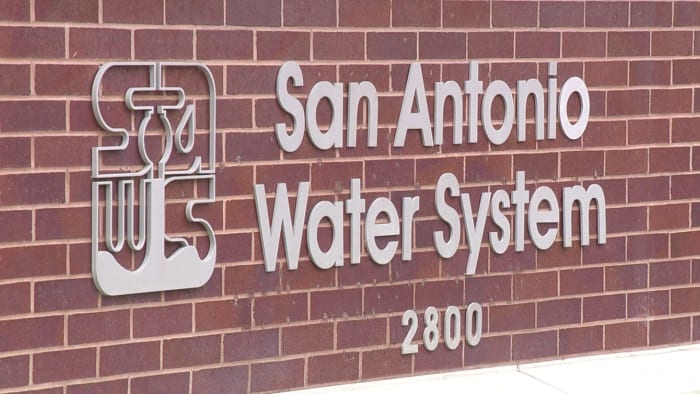
SAN ANTONIO – Higher fines and a new surcharge for heavy water users are among the new proposed drought rules up for a vote before the San Antonio City Council on Thursday.
Officials with the San Antonio Water System say current drought restrictions are not doing enough to save water. So SAWS officials have proposed new rules for watering hours, the use of drip irrigation, an extra charge for the biggest water users, new irrigation inspection, and a way to go after water wasters in suburban cities.
“Fundamentally, most of it is about getting savings from about 10% more of the community,” SAWS Vice President of Conservation Karen Guz told council members in a Jun. 13 briefing. “As I said, most people are doing what we asked them to do, and we’re trying in these changes to not inconvenience those folks further.”
SAWS trustees approved the changes last month, and the city council appears poised to approve the changes. If approved, new restrictions on watering hours could go into effect immediately. Increased fines and surcharges wouldn’t happen until mid-July.
Here’s a look at each of the changes.
DROUGHT RULE VIOLATIONS
SAWS has four stages of watering restrictions, which are generally tied to the level of its primary water source, the Edwards Aquifer. The lower the aquifer gets, the less you’re allowed to water your lawn and garden.
The water system is currently at Stage 2, which restricts landscape watering to once a week during four-hour windows in the morning and evening.
But while the rules apply to all SAWS customers, not everyone can get punished for breaking them.
The $137 citations for drought rule-breakers only apply to customers in San Antonio or within five miles of its city limits. SAWS customers who live in other suburban cities, however, can’t get hit with the municipal citation.
Instead, SAWS officials want to start charging violators directly through their SAWS bills, which would allow them to enforce the penalties across the board. Trustees also approved raising the cost of the penalties for larger users and repeat offenders.
Customers would be able to appeal the fees through a committee of non-SAWS employees. First-time residential violators would also have the option to avoid the fee by taking an online course.
HEAVY USER SURCHARGE
Under the utility’s Stage 1 and Stage 2 drought restrictions, customers can only water their landscaping once a week. As currently written, Stage 3 restrictions reduce that to once every other week.
As that restriction would affect everyone, including the customers who are already conserving water, Guz said the utility wants to try a different approach.
The every-other-week watering restriction would be held in reserve for Stage 4, she said. Instead, going to Stage 3 would mean hitting the top 5% of residential water users with an extra surcharge.
For every 1,000 gallons a customer uses above a set threshold — 20,000 for residential customers — they are charged an extra $10.37. Last summer, the average single-family home used fewer than 8,000 gallons a month, Guz said.
WATERING HOURS
Once SAWS institutes watering restrictions, landscape irrigation is confined to only the morning and evening.
Under Stage 1, the watering periods are before 11 a.m. and after 7 p.m. Once Stage 2 is in place, the hours are restricted further to between 7-11 a.m. and 7-11 p.m.
However, Guz said people have asked about watering even earlier in the day, and the utility wants to save power during the evening peak hours for energy use.
SAWS is recommending switching the watering periods to before 10 a.m. and after 9 p.m. during Stage 1 restrictions and 5-10 a.m. and 9 p.m.-12 a.m. during Stage 2.
DRIP IRRIGATION
Unlike sprinkler systems or even soaker hoses, SAWS has very few regulations on the use of drip irrigation. Depending on the watering restriction stage, it can be used six to seven times more often than other types of landscape watering.
While Guz said drip irrigation is more efficient than spray irrigation because it has less evaporation, it generally applies water “as fast as spray irrigation.”
The systems have recently “exploded” in popularity, and Guz originally recommended putting them under the same restrictions as spray irrigation.
However, SAWS trustees ended up approving a partially rolled-back version.
“Kind of met in the middle,” Guz said.
Though drip irrigation would still be allowed on fewer days than it is now, it would still be allowed more often than spray irrigation.
District 2 Councilman Jalen McKee-Rodriguez said during a June 13 council discussion that he supported the original recommendation to restrict drip irrigation to once-a-week.
INSPECTING NEW IRRIGATION SYSTEMS
SAWS also plans to begin inspecting new irrigation systems to ensure they meet standards.
Poorly designed and installed irrigation systems can waste 20% of water, according to the utility. Guz said the utility would inspect the plans as well as the final system.
It could require SAWS to do about 10,000 inspections each year, though Guz said they do not plan to begin phasing in the inspections until January.
Original News Source
Click here for San Antonio HOA Management
